Fraction by Sinevibes video demo from Sinevibes on Vimeo.
Sinevibes has been on a roll lately. The one-man Mac plug-in shop keeps churning out elegant, attractive plug-ins with a consistent color-coded visual interface, variations on a theme that invariably include clever twists.
And now, this.
Fraction isn’t the first slice repeater plug-in. But it might be the most direct and intuitive.
I’ve been playing with it for a bit, and it’s tough to describe just how much it’s able to do, or how quickly you can get at that range. Far from just adding some stuttering effects, you can add really subtle rhythmic and timbral variations or make a near-unrecognizable sound warped into something new. It does this by letting you directly get at the bit of the sample you want to modulate, then providing a host tools to work with from there.
EDM? Sure. IDM? Most definitely. But once you get past breaking up drum loops, you can also treat Fraction as a micro-DAW / sampler / effect unit, a sound-reshaping instrument you can use on anything.
Okay, so what does it actually do?
First, you can place slice markers on the sound directly, then use animated controls to determine what to do slice-by-slice. In fact, I must admit that when I first opened it up, I briefly was confused only because I wasn’t accustomed to effects processors letting me work that immediately with sound.
From there, you get:
- Eight audio slicers mapped atop a real-time audio waveform display
- Each slicer has its own controls: size, repeat count, forward/reverse, duck/gate. So whereas more traditional slicers force you to rely on randomization or overall timing controls, here you can say, “you – that slice – I want you to do this.”
- Eight slice sets for your slicers, each with different positions and on/off switches. (Yes, that’s 64 individual slices)
- Each slice has three effect units and four “animation generators” for controlling modulation of those effects.
- Each effect unit can choose among 15 algorithm types: low-pass, high-pass, band-pass and band-reject filters, phaser, barber-pole phaser, positive and negative flangers, chorus, bit depth and sample rate reducers, analog drive, circuit-bent filter, frequency shifter and pitch shifter.
- Sync to tempo and even time signature automation.
Sinevibes continues to be a Mac-only affair, but the payoff for Mac Audio Unit users is significant: any Intel Mac running operating systems as early as 10.6 are supported in 32- and 64-bit format with Retina resolution. I will say, I notice some significant CPU consumption on my MacBook once I start turning on all the modules. (Clarification: with more testing, that’s more like minor CPU consumption when I turned on everything. Ah ha. Remember how I said this is a bit like having a DAW inside your DAW? Well, you’re running all those effects at once, so… let me rephrase this. When I inevitably succumb to my desire to turn absolutely everything on, CPU usage actually remains reasonably modest.)
US$69 now, or be a fanboy/fangirl of Sinevibes and get everything for US$299.
I may offer some demos later this month, but in the meantime, here you go. These are good basic examples, but it can actually go a lot further, particularly with different sound content.
Now, the obvious comparison here is to iZotope’s Stutter Edit, produced in collaboration with BT. At their core, the idea is related: each uses a bunch of rhythmic variations and effect modules to reshape the sound. The UIs are completely different, though: Stutter Edit uses push-button step sequencers and builds “gestures” around them, compared to Fraction’s waveform view and clickable slice-by-slice controls. Stutter Edit was actually always a bit too deep for me; I got up and running with Fraction right away and really love its waveform-centric interface. I also like the flatter UI aesthetic.
Then again, Stutter Edit, while substantially pricier at US$299, has a huge amount of power, lots of ideas around live performance (via MIDI), and libraries of presets to get rolling. These two are begging for a comparison, not so much because I expect a “winner” from the two, but because they start with the same fundamental idea and go in radically different directions.
More:
http://www.sinevib.es/fraction
